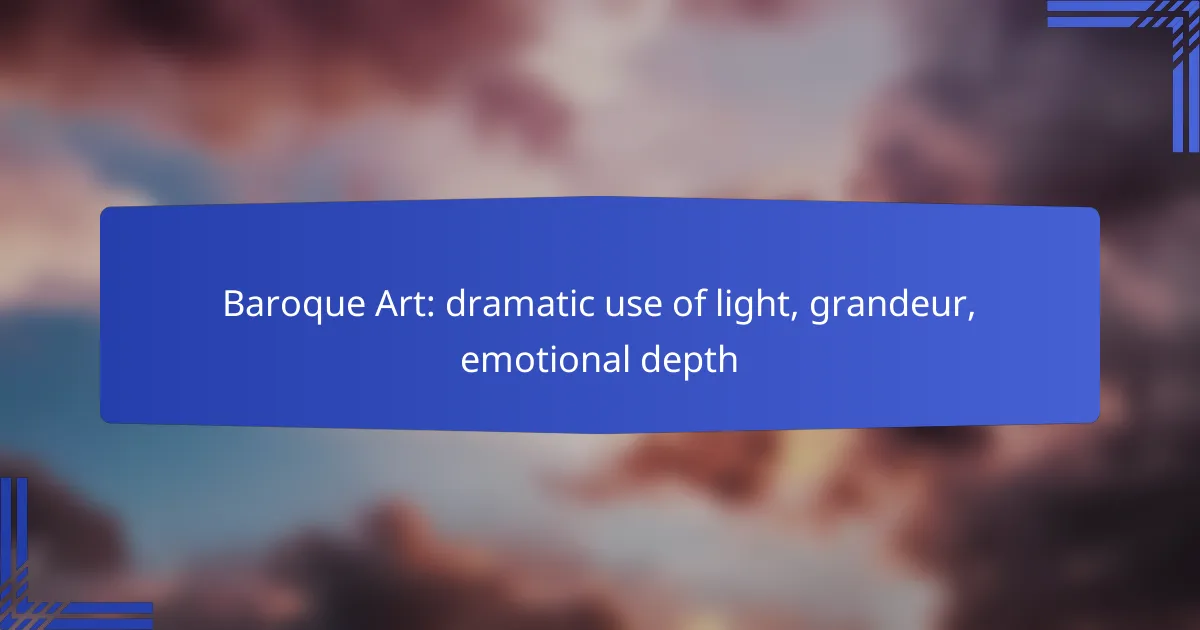Baroque Art, emerging in the 17th century, is renowned for its dramatic use of light, grandeur, and emotional depth. Artists like Caravaggio, Peter Paul Rubens, and Gian Lorenzo Bernini masterfully employed stark contrasts between light and shadow to draw viewers into their dynamic compositions, evoking powerful emotions and highlighting intricate details.
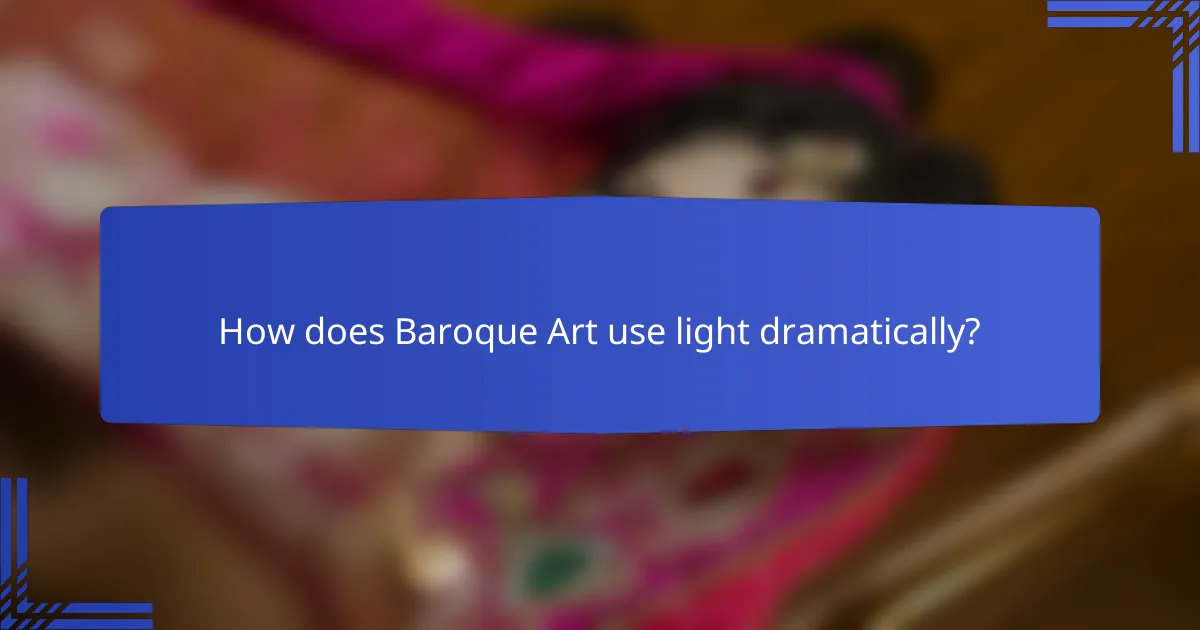
How does Baroque Art use light dramatically?
Baroque Art employs dramatic lighting to enhance emotional depth and create a sense of grandeur. This technique often involves stark contrasts between light and shadow, drawing the viewer’s attention to key elements within the artwork.
Chiaroscuro technique
The chiaroscuro technique is a hallmark of Baroque Art, characterized by the strong interplay of light and dark. Artists like Caravaggio used this method to create a three-dimensional effect, making figures appear more lifelike and dynamic. By highlighting certain areas while leaving others in shadow, the technique adds drama and intensity to the composition.
To effectively use chiaroscuro, artists often focus on a single light source, which can create a striking focal point. This approach not only enhances the emotional impact but also guides the viewer’s eye through the artwork.
Contrast in paintings
Contrast in Baroque paintings is essential for conveying drama and tension. Artists frequently juxtaposed bright highlights against deep shadows, which amplifies the emotional resonance of the scene. This technique can evoke feelings of awe or turmoil, depending on the subject matter.
For example, in religious artworks, the use of contrast often emphasizes divine figures, making them appear more powerful and significant. This strategic use of light and dark not only enhances visual interest but also deepens the narrative within the painting.
Illumination in architecture
Illumination in Baroque architecture plays a crucial role in creating an awe-inspiring atmosphere. Grand structures often feature large windows and strategically placed light sources that enhance the dramatic effect of the interiors. This use of natural and artificial light can transform spaces, making them feel more expansive and inviting.
Architects like Gian Lorenzo Bernini designed churches and public buildings with light in mind, using it to highlight key architectural features. The interplay of light and shadow in these spaces not only enhances their grandeur but also guides visitors through a sensory experience that reflects the emotional depth of Baroque Art.
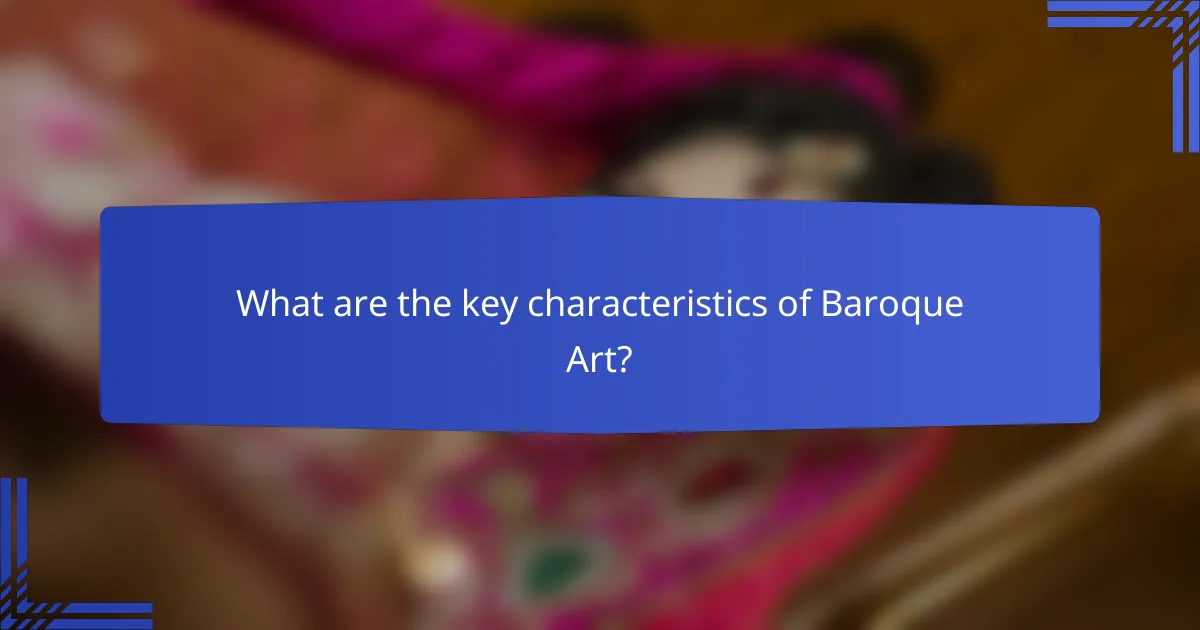
What are the key characteristics of Baroque Art?
Baroque Art is characterized by its dramatic use of light, grandeur, and emotional depth. This style emerged in the 17th century and is known for its ability to evoke strong feelings through dynamic compositions and intricate details.
Emotional depth
Emotional depth in Baroque Art is achieved through intense expressions and dramatic scenes. Artists often depicted religious and historical subjects, aiming to connect with viewers on a personal level. For instance, the works of Caravaggio showcase raw human emotions, drawing audiences into the narrative.
To enhance emotional impact, artists utilized chiaroscuro, a technique that contrasts light and shadow. This not only highlights key figures but also creates a sense of drama, making the viewer feel the weight of the moment being portrayed.
Grand scale
Baroque Art is known for its grand scale, often seen in large paintings and elaborate sculptures. Artists aimed to impress viewers with monumental works that conveyed power and authority, frequently commissioned by churches and monarchs. For example, the expansive ceilings of St. Peter’s Basilica in Vatican City exemplify this characteristic.
When creating or appreciating Baroque works, consider the use of space and the scale of elements within the composition. Larger pieces often invite viewers to step back and take in the full grandeur, while smaller details draw them in for closer inspection.
Dynamic movement
Dynamic movement is a hallmark of Baroque Art, characterized by swirling forms and figures that seem to be in motion. This technique creates a sense of energy and life within the artwork, making it feel as if the scene could continue beyond the canvas. Artists like Gian Lorenzo Bernini exemplified this through his sculptures, which capture figures in mid-action.
To appreciate dynamic movement, observe how artists arrange figures and use lines to guide the viewer’s eye throughout the piece. Look for diagonal lines and asymmetrical compositions that contribute to a feeling of movement and excitement, drawing the viewer into the scene.

Which famous Baroque artists should you know?
Key Baroque artists include Caravaggio, Peter Paul Rubens, and Gian Lorenzo Bernini, each known for their dramatic use of light, grandeur, and emotional depth in their works. Understanding their contributions provides insight into the Baroque movement’s impact on art history.
Caravaggio
Caravaggio is renowned for his innovative use of chiaroscuro, the strong contrast between light and dark, which enhances the emotional intensity of his paintings. His works often depict religious themes with a raw realism that was groundbreaking for the time.
Some of his most famous pieces include “The Calling of Saint Matthew” and “Judith Beheading Holofernes,” both showcasing his ability to capture dramatic moments. Caravaggio’s style influenced many artists and helped shape the Baroque aesthetic.
Peter Paul Rubens
Peter Paul Rubens is celebrated for his vibrant color palette and dynamic compositions that convey movement and emotion. His paintings often feature voluptuous figures and dramatic scenes, reflecting both classical and contemporary themes.
Rubens’ notable works, such as “The Descent from the Cross” and “The Garden of Love,” exemplify his mastery of light and shadow, creating a sense of depth and grandeur. His influence extended beyond painting to include sculpture and architecture, making him a pivotal figure in Baroque art.
Gian Lorenzo Bernini
Gian Lorenzo Bernini is a key figure in Baroque sculpture and architecture, known for his ability to convey emotion and movement in stone. His works, such as “The Ecstasy of Saint Teresa,” capture dramatic moments with intricate details and dynamic poses.
In addition to sculpture, Bernini designed significant architectural projects, including the colonnade at St. Peter’s Basilica in Vatican City. His contributions helped define the Baroque style, emphasizing grandeur and emotional depth in both sculpture and architecture.
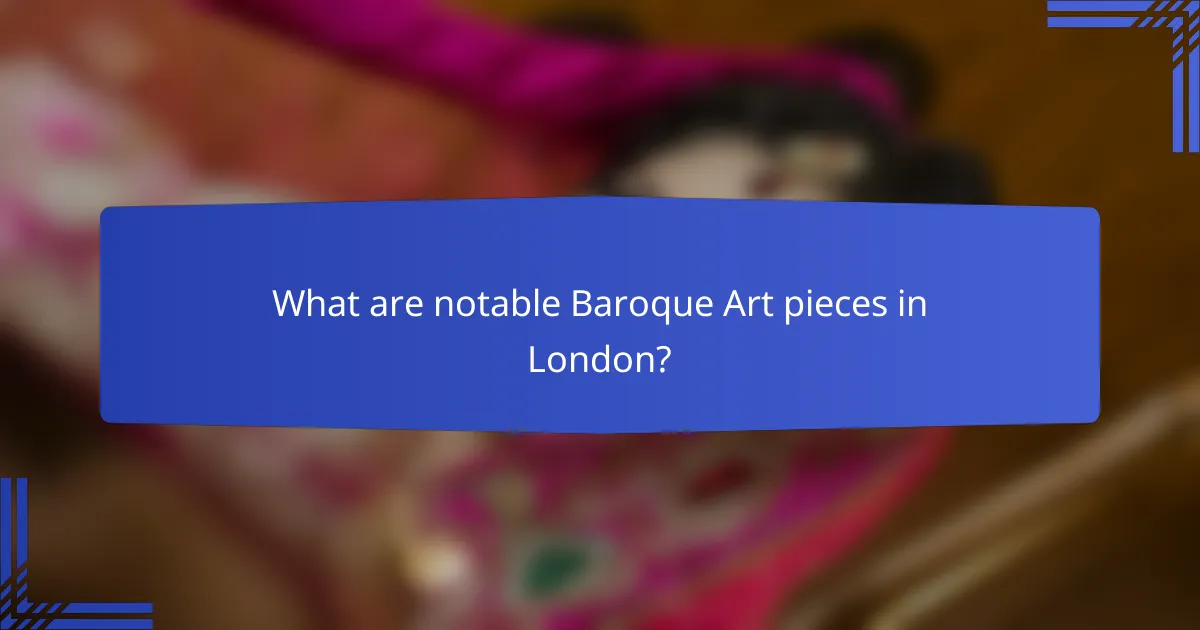
What are notable Baroque Art pieces in London?
London is home to several remarkable Baroque Art pieces that showcase the dramatic use of light, grandeur, and emotional depth characteristic of the period. Notable works include masterpieces by renowned artists such as Rembrandt and Bernini, which can be found in various galleries and museums across the city.
The Night Watch by Rembrandt
The Night Watch, painted in 1642, is one of Rembrandt’s most famous works and a prime example of Baroque art’s dramatic use of light and shadow. This large-scale painting depicts a group of militiamen in action, showcasing their vibrant uniforms and dynamic poses.
Visitors can view The Night Watch at the Rijksmuseum in Amsterdam, but its influence is felt in London, where art enthusiasts can explore similar themes in local collections. The painting’s composition and use of chiaroscuro create a sense of movement and excitement, drawing viewers into the scene.
Ecstasy of Saint Teresa by Bernini
Ecstasy of Saint Teresa, sculpted by Gian Lorenzo Bernini in the 17th century, captures the spiritual and emotional depth typical of Baroque art. This masterpiece is housed in the Cornaro Chapel in Rome, yet its impact resonates in London, where many galleries feature works inspired by Bernini’s dramatic style.
The sculpture portrays Saint Teresa in a moment of divine ecstasy, surrounded by angelic figures, with intricate details that enhance the emotional intensity. The use of light in the chapel highlights the sculpture, emphasizing its grandeur and inviting contemplation.
Portrait of a Man by Rembrandt
Portrait of a Man, another significant work by Rembrandt, exemplifies the artist’s skill in capturing human emotion and character through light and shadow. This painting, which showcases a somber yet compelling figure, reflects the Baroque focus on individuality and psychological depth.
While this specific portrait may not be on permanent display in London, many institutions feature similar works that highlight Rembrandt’s techniques. Art lovers should look for exhibitions that focus on portraiture to appreciate the nuances of Baroque artistry in capturing the human experience.
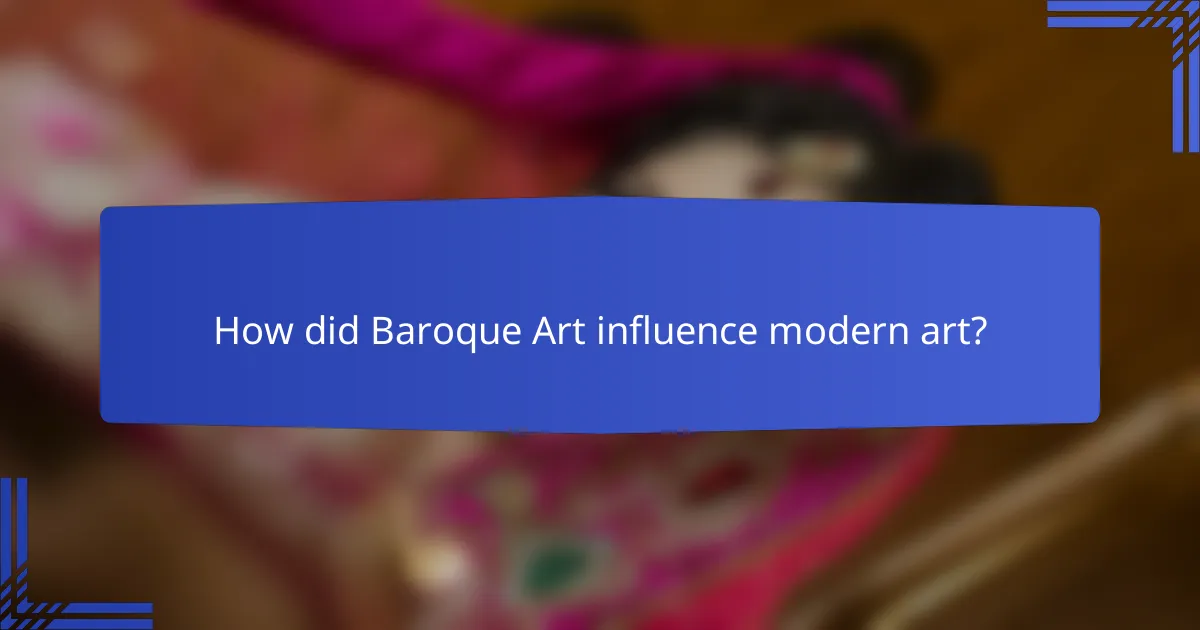
How did Baroque Art influence modern art?
Baroque Art significantly influenced modern art through its emphasis on emotion, dramatic lighting, and the integration of various art forms. These elements have shaped contemporary artistic expressions, encouraging artists to explore emotional depth and innovative techniques.
Emphasis on emotion
Baroque Art is characterized by its intense emotional expression, which has inspired modern artists to prioritize feelings in their work. This focus on emotion allows for a deeper connection between the artwork and the viewer, often evoking strong reactions.
Contemporary artists often use similar techniques to convey emotion, such as bold color choices and dynamic compositions. For example, the use of exaggerated facial expressions and body language in modern portraiture echoes the emotional intensity found in Baroque masterpieces.
Use of dramatic lighting
The dramatic use of lighting in Baroque Art, known as chiaroscuro, has profoundly impacted modern artistic techniques. This method creates a strong contrast between light and shadow, enhancing the three-dimensionality of subjects and adding a sense of drama.
Modern artists frequently employ similar lighting techniques to create mood and focus within their works. For instance, photographers and painters alike utilize strategic lighting to highlight specific elements, drawing the viewer’s attention and enhancing the overall emotional impact.
Integration of various art forms
Baroque Art often blended different artistic disciplines, such as painting, sculpture, and architecture, to create cohesive and immersive experiences. This integration has influenced modern art movements that emphasize multidisciplinary approaches, encouraging artists to experiment across various media.
Today, many contemporary artists incorporate elements from different art forms, such as combining digital media with traditional painting techniques. This fusion not only enriches the artwork but also reflects the Baroque legacy of innovation and creativity in the arts.
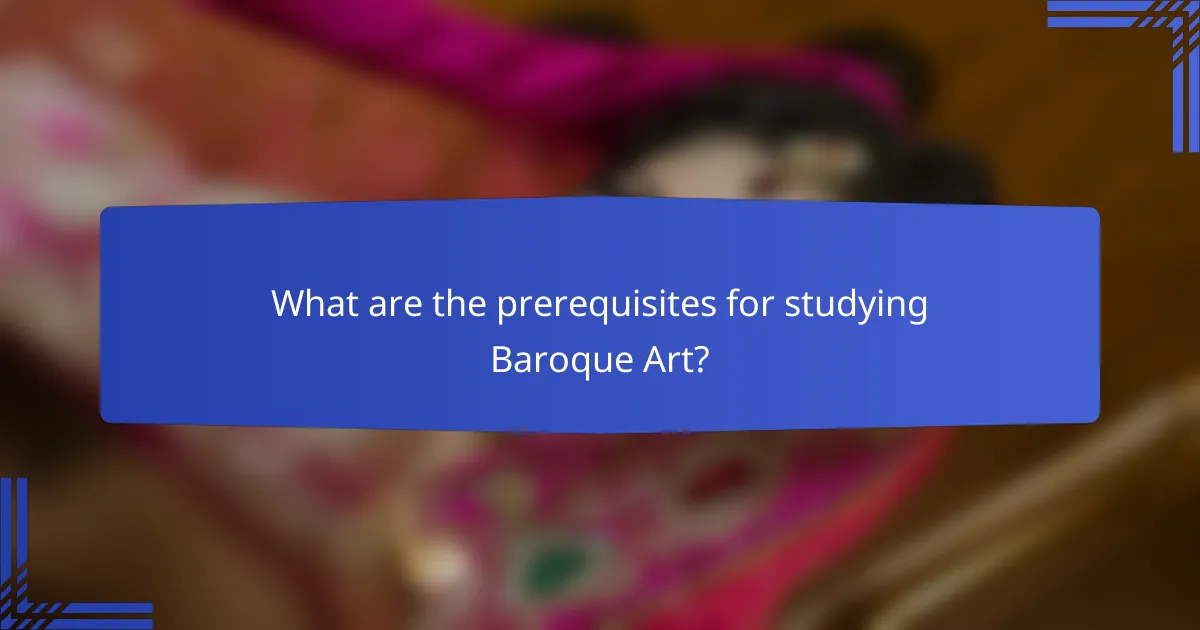
What are the prerequisites for studying Baroque Art?
To study Baroque Art effectively, a foundational understanding of Renaissance Art is essential, as Baroque emerged as a response to it. Familiarity with key concepts, techniques, and artists of the Renaissance will provide a solid base for exploring the dramatic and emotional depth characteristic of Baroque works.
Understanding of Renaissance Art
Renaissance Art, spanning roughly from the 14th to the 17th century, emphasizes humanism, proportion, and perspective. Artists like Leonardo da Vinci and Michelangelo focused on realism and the beauty of the human form, setting the stage for the emotional expressiveness found in Baroque Art.
Key elements of Renaissance Art include the use of chiaroscuro, which is the contrast of light and shadow, and a balanced composition. Understanding these principles will help in recognizing how Baroque artists like Caravaggio and Bernini expanded upon them to create more dynamic and dramatic works.
When studying Baroque Art, consider how the Renaissance laid the groundwork for its techniques. For instance, while Renaissance artists aimed for harmony and ideal beauty, Baroque artists sought to evoke emotional responses through movement, tension, and theatricality, making this historical context crucial for deeper comprehension.
